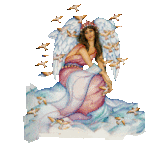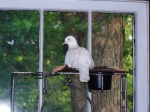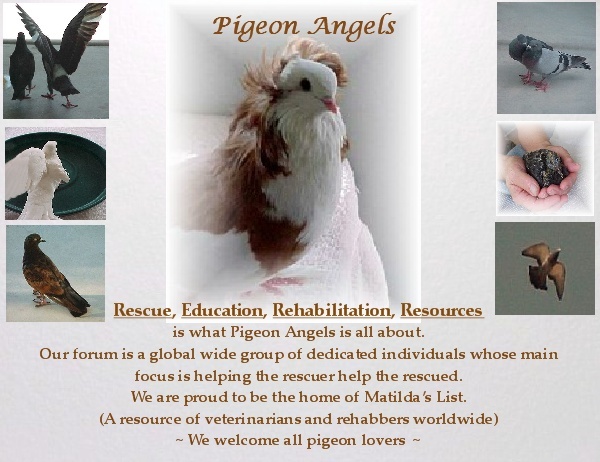Matilda
Special Pigeon Angel

Posts : 9198
Join date : 2009-01-11
Location : Pacific Northwest of the United States of America
 |  Subject: What is a Gram Stain? Subject: What is a Gram Stain?  Sun Feb 07, 2010 11:42 am Sun Feb 07, 2010 11:42 am | |
| Gram Stain
By
Scott McDonald DVM
Midwest Exotic Animal Hospital
1923 South Mannheim Road
Westchester, IL 60154 | This is a simple test used to check for the presence and quantities of various type of bacteria and yeast from the oral cavity, cloaca, or some other site.
To perform the test, a sterile cotton-tipped applicator stick is used to swab the collection site. The sample is smeared on to a microscope slide and transported back to the laboratory. The slide is then stained with several dyes in order to "color" the bacteria and yeast for identification.
There are four steps to the Gram Stain technique:
- The microscope slide is flooded with Crystal Violet which stains everything purple. The bacteria take up the stain through tiny holes in their wall known as pores. Certain types of bacteria have large pores, others have only small pores.
- The excess Crystal Violet is rinsed off of the slide and then iodine is added. This has an astringent or "closing" action on the pores. The smaller pores are closed completely, the larger pores only partially
- The slide is decolorized with a chemical that removes all the Crystal Violet from the bacteria whose pores are only partially closed. However, the Crystal Violet is trapped in the bacteria whose pores are totally closed
- A pink dye called Safranine is added to the slide for 30 seconds, then rinsed off. It stains the inside of the bacteria whose pores are only partially closed but not those whose pores are complete closed (these bacteria remain purple
When the process is complete those bacteria (with larger pores) which stain pink are known as Gram negative bacteria while those bacteria with small pores are called Gram positive bacteria.
Bacteria occur in several shapes. The two primary shapes are cocci (round or oval) and bacilli (rod-shaped). Other less common shapes are coccobacillic (rounded, slightly rod-shaped) and spirochetes (curved spirals).
All cocci are Gram positive bacteria. These include Streptococcus sp. And Staphylococcus sp. which make up the majority of the normal bacteria flora seen in healthy psittacine birds. Lactobacillus is an example of this type of bacteria which we are all familiar with in yogurt or in a number of commercial products used to inoculate a bird's GI tract with "normal" bacteria.
Gram negative rods consist of most of the bacteria considered "potentially pathogenic" or disease producing in birds. Examples include E. coli, Pseudomonas, Proteus, Citerbacter and Enterbacter sp.
Coccobacillic shaped bacteria (CB) are Gram negative and the most common that is disease producing is Klebsiella sp. Spirochetes are also Gram negative. These are rare but they have been associated with disease in the respiratory tract of cockatiels.
It is useful to estimate the number of bacteria and general proportions of Gram positives to Gram negatives present on each slide. Estimates are classified as follows
- Rare - only a few bacteria on slide
- +1 occasional bacteria on slide
- +2 5-15 bacteria per oil immersion field
- +3 15-75 bacteria per oil immersion field
- +4 more than 75 per oil immersion field
By determining an estimate of the number and types of bacteria present, the veterinarian can better determine if specific cultures or other tests, treatments, or management changes should be carried out.
In general, most healthy psittacines have primarily Gram positive bacteria in their GI tract. Gram negative bacteria may be found in smaller numbers or percentages than Gram positive bacteria. Thus in a potentially sick bird, we are looking for increased numbers and proportions of Gram negative bacteria compared to Gram positive bacteria.
Yeasts are types of fungi. The most common is Candida sp. Spores of this fungi are ubiquitous, however, they may become pathogenic in debilitated or immuno-suppressed individuals. Their presence and in what numbers and forms help determine if treatment is necessary.
Yeast appear in three forms - single, budding, or pseudohyphae (chains). These all stain Gram positive and are up to four times larger than bacteria.
Small numbers of single yeast cells are common in normal healthy psittacines. A lot may be present if the bird has been eating bread. Larger numbers of budding yeast or the presence of pseudohyphae indicates the yeast are multiplying in the GI tact and that a disease state may exist. Examples include young birds with sour crop or infection in the oral cavity or birds on long term antibiotics which kill normal bacteria causing a yeast overgrowth.
Gram Stain
- Source: either choana (roof of the mouth), cloaca (just inside the vent), feces, or other site
- Gram Negative Rods: most common disease producing bacteria in psittacines. Examples include E. coli, Pseudomonas, Enterbacter sp. May be found in small numbers in healthy birds but should not be the predominate bacteria seen
- Gram Negative CB: Coccobacillic-shaped bacteria. Most common example is Klebsiella sp. may produce disease if found in large numbers
- Gram Positive Rods: Normal flora in psittacines. Most common example is Lactobacillus sp. May be the predominate organism found
- Gram Positive Cocci: Normal flora in psittacines. Examples include Staphylococcus and Streptoccus bacteria. May be the predominate organism found. In some instances, certain species of Staph or Strep may cause disease
- Yeast: Fungi; Candida sp. is the most common example seen. May be normal in small numbers but large numbers of growing organisms may indicate a problem
- Other: occasionally parasites or other interesting artifacts are seen
|
| |
|
AZWhitefeather
Owner/Administrator

Posts : 10863
Join date : 2009-01-11
Location : Arizona Southwestern United States
 |  Subject: Re: What is a Gram Stain? Subject: Re: What is a Gram Stain?  Sun Feb 07, 2010 12:56 pm Sun Feb 07, 2010 12:56 pm | |
| | |
|
Teresa
Administrative Member

Posts : 5381
Join date : 2009-07-23
Location : Portugal
 |  Subject: Re: What is a Gram Stain? Subject: Re: What is a Gram Stain?  Mon Mar 01, 2010 9:34 pm Mon Mar 01, 2010 9:34 pm | |
| Thank you for posting this information, Charis. I'd heard the terms 'gram-positive' and 'gram-negative bacteria' but didn't know what that involved until now. A very interesting read!  | |
|
EgypSwiftLady
Special Pigeon Angel

Posts : 1526
Join date : 2009-10-23
Location : Wisconsin
 |  Subject: Re: What is a Gram Stain? Subject: Re: What is a Gram Stain?  Tue Mar 02, 2010 9:30 am Tue Mar 02, 2010 9:30 am | |
| Thats too funny Dr. Mcdonald used to be our vet years ago when we raised parrots!  Great info Thanks for posting it Charis!  | |
|
AZWhitefeather
Owner/Administrator

Posts : 10863
Join date : 2009-01-11
Location : Arizona Southwestern United States
 |  Subject: Re: What is a Gram Stain? Subject: Re: What is a Gram Stain?  Tue Mar 02, 2010 10:23 pm Tue Mar 02, 2010 10:23 pm | |
| - EgypSwiftLady wrote:
- Thats too funny Dr. Mcdonald used to be our vet years ago when we raised parrots!

That's pretty  Robin. | |
|
Matilda
Special Pigeon Angel

Posts : 9198
Join date : 2009-01-11
Location : Pacific Northwest of the United States of America
 |  Subject: Re: What is a Gram Stain? Subject: Re: What is a Gram Stain?  Wed Mar 17, 2010 8:20 pm Wed Mar 17, 2010 8:20 pm | |
| | |
|
Sponsored content
 |  Subject: Re: What is a Gram Stain? Subject: Re: What is a Gram Stain?  | |
| |
|


